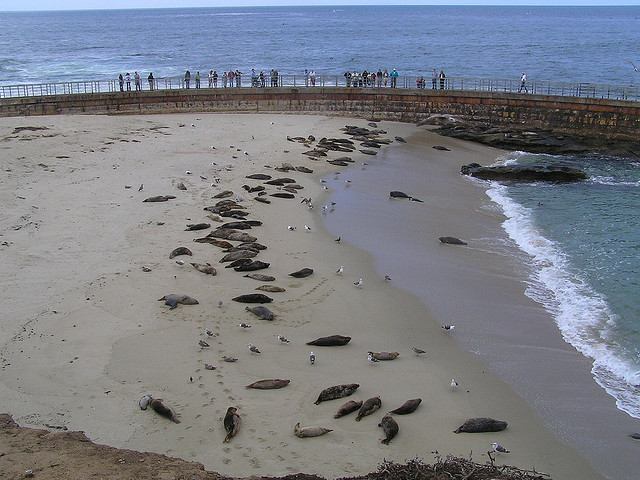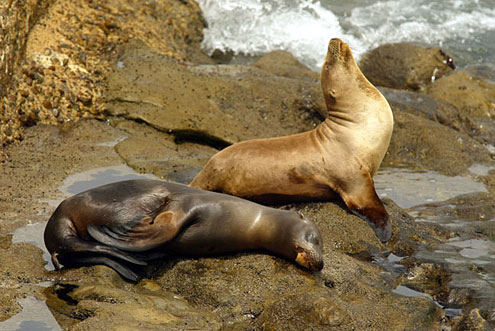The Bureaucratic Plight of the La Jolla Seals
September 1st, 2010

Seals at the Children's Pool in La Jolla, site of Seal Rock before the pool's construction.
Seal Rock Bluff
Helen Browning Scripps was one of the great civic boosters and patrons of pre-World War II San Diego, leaving a legacy of public places and parks which continue to enhance the lives of the city’s residents today.
While in San Diego, Mrs. Scripps longed for a safe place for children to play in the surf of her beloved La Jolla Cove, and in 1931 arranged for a sea wall to be built at the site of an area known as Seal Rock Bluff, a spot where seals were often seen resting, especially during pupping season.
While not intended as a philanthropic misstep, what came to be known as the Children’s Pool became a controversial legacy in the late 1980s when seals began returning en masse to the rock their relatives had instinctively called home for centuries, and began using Mrs. Scripps’ perfectly sheltered beach during pupping season. Even though Seal Rock itself was buried beneath brick and concrete during the pool’s construction in the 1930s, the seals’ instinctive programming has kept them returning to the same location year after year.
While the seals have become one of La Jolla’s most popular, must-see tourist stops, there remains no formal designation of the Children’s Pool as a seal-only refuge, and the area is subject to frequent police visits and lifeguard oversight to minimize contact between humans and seals. Seal activists also keep a constant watch over the beach, taking collections and passing out literature on the seals and the special bond they share with the location which became Children’s Pool.
Today, the status of the Children’s Pool remains in question, as some La Jolla residents continue to demand the city return the Children’s Pool to its “original” condition, before the seals began to re-colonize and re-claim the Children’s Pool as their instinctive home. The city of San Diego has played an impressive, if cowardly game of political hot potato, batting the matter from the city council to the mayor’s office to the county board of supervisors to the California Coastal Commission and back for years. This has led to numerous rulings to leave the seals alone in accordance with federal law, to proposals to dredge the cove in order to allow the sea to cleanse the area of high coliform levels, though few public health officials believe the Children’s Pool can be returned to conditions safe for human use any time soon.
Cruel Summer
This summer has been especially tough for the La Jolla seals. Things were looking up earlier in the year when the San Diego city council voted to increase seal protection and close the beach during pupping season, but shortly afterwards, the rope barrier which keeps the public at a safe distance from the seals was taken down. San Diego Mayor Jerry Sanders, curiously, has refused to put it back.
With no rope in place to keep people from approaching the seals, the Children’s Pool has, on numerous occasions this summer, been overrun with humans. The result has been bedlam. While most individuals genuinely, harmlessly want to “get closer” to look at the seals, they don’t realize approaching too closely forces the seals into the water in a panic. After hours of battling the surf and expending energy along the waterline as humans continue to swell the beach, the seals become dangerously tired, and are left unable to come back ashore at the moment they need to be there the most. This is why the rope barrier was there in the first place.
As the weeks progressed this summer, the lack of any ability to enforce the closed beach rule and the resulting chaos has become a public relations black eye for San Diego. Along with the curious who simply want to get close, there are also irresponsible, even violent individuals who try to do more than touch the seals. Far too many reports have been made this year of people, drunk and sober, throwing objects at the seals, kicking them, and chasing them.

Seals soaking in the sun.
What You Can Do
If you live in Southern California or the San Diego area, there are several things you can do:
Write or call Mayor Jerry Sanders and ask him why he refuses to put the rope barrier back up, despite public appeal and the city council’s request for him to do so (to say nothing of the fact a first-year oceanography student at Scripps could give him 10 reasons why it’s a good idea, beyond the fact it’s humane).
You can e-mail Mayor Sanders HERE, or call his office at (619) 236-6330.
We at Treehuggers International ask you to express yourself in a professional and responsible manner and tone of voice when speaking to the mayor’s office.
You can also attend a pair of public meetings and make your position clear to your elected officials in a responsible, professional, and if possible, quotable manner. There are two meetings coming up:
September 2nd, 2010, 6:00 pm
La Jolla Planning Association
La Jolla Recreation Center
615 Prospect Street
Hear (again) the city’s proposal for a year-round rope, the way it was for years. Why was the rope up for years? It was a functional, non-intrusive demarcation line.
September 15th, 2010, 8:30 pm
San Diego City Hall
202 C St., 12th floor
The same issue will be heard by a “hearing officer” from the city’s Development Services Department.
We encourage you to take your families, and demonstrate to your children how democracy works, and how the public can have a say in city matters. When people fail to raise their voice, politicians don’t notice.
The La Jolla Friends of the Seals offer these helpful talking points:
(a.) The rope is a guideline to promote public safety – to keep people a safe distance from seals and the seals a safe distance from people.
(b.) A resolution was passed by the San Diego City Council on January 8th, 2007 which stated the Environmental Division of the city’s Development Services had determined the replacement of the rope barrier is exempt from the provisions of CEQA (the California Environmental Quality Act) because it is a project “not to exceed five acres in size to assure the maintenance, restoration, enhancement or protection of habitat for fish, plants or wildlife.”
(c.) The small number of people who want to continue using the beach in spite of the presence of pregnant seals who prefer the bluff side for entry, resting and sleeping, may still have their access, but the rope does deter the majority of seal viewers.
(d.) The city’s policy of “shared use” has left the seals coming short of their share, as the current signage encourages people to go on the beach “at all times.” Given the seals natural tendency toward fleeing when people get too near, they seldom get their fair share of beach time.
We at Treehuggers International would also add, putting the rope back where it has stood and worked for years in lieu of a more permanent solution is the responsible thing for San Diego, or any city, to do. As a vacation destination, the eyes of the nation and the world are on San Diego and how the city treats its wild neighbors on the beach. Leaving the Children’s Pool in a state of unregulated, terrified seal pandemonium does not reflect well on this community.
A very special Treehuggers International thanks to Deana Gunn for her persistence on this matter and significant help with this piece.





